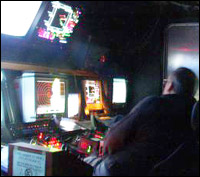The towers
Kelley had seen similar stony edifices in other places, created by the special chemistry of mineral-laden heated water. In fact, the structures resembled those in "Faulty Towers," the fanciful name for a photomontage of a famous "black smoker" site displayed on the wall of Atlantis' galley.
Looking like a Victorian house gone mad, this scene was captured during a previous University of Washington expedition aboard Atlantis to the Endeavour vent fields in the northeast Pacific Ocean off of Seattle, along the Juan de Fuca Ridge spreading center. Spires there are swarming with colonies of animals that thrive on warmth, energy and chemicals from water as hot as 380 degrees centigrade (715 degrees Fahrenheit). The "smoke" plumes are clouds of precipitating minerals being carried up by the superheated flow.

Fig. 3. A chimney in the Endeavor vent field that hosts diverse macrofaunal and microfaunal communities. Image provided by Deborah Kelley, University of Washington.
No smokers were evident within the newly discovered Atlantic vent field. Also conspicuously absent were obvious signs of the biological activity so evident at other fields. There were none of the mussels, clams or tubeworms that abound at other hydrothermal vent sites, drawing on their warmth and nutrients.
What was apparent was the huge sizes of the structures. They were later determined to be up to 60 meters (196 feet ) tall, making Faulty Towers look like a dollhouse by comparison.
"We're not in a hurry here," Karson told Argo-II pilot James Varnum and navigator Thomas Crook, who were skillfully maneuvering a cable-towed device that was, figuratively, hanging by a thread.
"We find vents in lots of places," said Kelley. "But not like these." One big question is why they are "way off axis," she added. This location is miles west of what would be the normal source of heat for these kinds of thermal vents: cooling magma chambers associated with sporadic volcanic activity along the Mid-Atlantic Ridge.

Fig. 4. The top of an active chimney in the hydrothermal vent field Lost City taken from the submersible Alvin. The chimney rises 180 feet above the seafloor and is nearly 30 feet in diameter at its top. White carbonate minerals, which cap active portions of the chimneys, precipitate from warm vent fluid. Photo courtesy National Science Foundation new release, http://www.nsf.gov/od/lpa/news/press/00/pr0093.htm.
Then there are analogous hot springs such as those at Yellowstone, heated by a different kind of volcanic system - so-called "hot spots."
Having an active vent field at this location would be completely unprecedented. Rock samples Alvin had brought up in the vicinity were mostly peridotites, materials somehow pulled up from deeper in the mantle than the basalts that make up Mid-Atlantic Ridge's volcanos and lavas.
"This doesn't look very active," Kelley added on that very early part of Monday. "I haven't seen any shimmering water." The physics of light makes water emerging from undersea thermal vents look different than the ocean water surrounding it. Such flows can be identified by their sparkling "shimmer" which looks somewhat like an interference pattern on a television screen.
At that point Cann, who had been awakened with the news, walked into the control room, looked at the video monitors, and shouted "Wow!...Wow!"

Fig. 5. ARGO control room.
Walking from the control van to the mess to fetch coffee for himself and the rest of the watch team, Karson said this "amazing" discovery changes the expedition's focus "in subtle, and not so subtle" ways. "That's why we came out here," he added. "To find something very exciting.
"Here we have something, visually so stunning, that is speaking to us so clearly about a process we hadn't expected that it literally jumped out in our faces. It was totally unexpected in this sort of environment. In what is a really cold place, it's telling us that hot water has been circulated here on a scale we would not have anticipated."
About 3 a.m. the plot further thickened when Kelley first saw shimmering water emerging from around "a little white cone" adjacent to a larger structure.
By about 5 a.m., when it was time to begin reeling Argo's 3,000 meter long tow wire back to the ship, the science team had identified numerous large spires and many more shorter ones. Looking at another monitor that displays sweeping sonar beam returns ghostly green and yellow images of the slope's topography, Karson estimated that the entire field might stretch over about 100 meters.
"Who knows? There may be more fields around," he said.
Today's pages:
"When I first saw them ..." | The towers | "... how little we know" | Life between a rock and a hot place | Plans for the lab back home

| 
|
|







